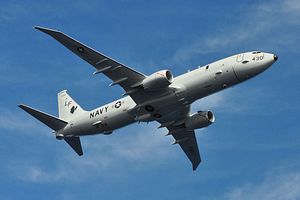The U.S. Department of State today approved the possible sale of six U.S.-made Boeing P-8A Poseidon maritime patrol aircraft for an estimated cost of $2.1 billion, the Defense Security Cooperation Agency (DSCA) said in a September 13 statement. The sale, which will take place through the U.S. government’s foreign military sales program, is still subject to congressional approval.
South Korea officially announced in June that it had opted to procure P-8A Poseidon maritime patrol aircraft for the Republic of Korea (ROK) Navy. Seoul has been mulling the purchase of P-8As for a number of years. (A plan to purchase 12 Lockheed Martin twin-turbofan S-3 Viking anti-submarine warfare aircraft was abandoned last year.) With North Korea gradually expanding its fleet of diesel-electric submarines, the ROK Navy wants to reinforce its anti-submarine warfare capabilities. The ROK Navy currently operates one squadron of P-3C Orion maritime patrol aircraft.
The ROK government’s principal impetus for boosting the ROK Navy’s ASW capabilities was the sinking of a Pohang-class corvette on March 26, 2010 in the Yellow Sea, killing 46 sailors. The ROK Navy warship ship was reportedly sunk by a torpedo fired from a Yono-class midget submarine, 10 of which are currently in service with the Korean People’s Navy (KPN), although it is unclear how many are operational. Notably, U.S. intelligence last year identified a new KPN sub class, designated Sinpo-C, likely capable of firing nuclear-tipped submarine-launched ballistic missiles.
“The ROK procured and has operated U.S.-produced P-3 Maritime Surveillance Aircraft (MSA) for over 25 years, providing interoperability and critical capabilities to coalition maritime operations,” the DSCA said in the statement. “The ROK has maintained a close MSA acquisition and sustainment relationship with the U.S. Navy over that period. The proposed sale will allow the ROK to modernize and sustain its MSA capability for the next 30 years. As a long-time P-3 operator, the ROK will have no difficulty transitioning its MSA force to P-8A.”
The P-8A is the military variant of Boeing’s Next-Generation 737-800 commercial aircraft. Originally, it was designed to replace the U.S. Navy’s fleet of P-3 Orion maritime surveillance aircraft. It is thought to be one of the world’s most advanced anti-submarine warfare aircraft currently in service. The aircraft, equipped with “advanced sensors, including an APY-10 radar system, can carry several types of bombs, Raytheon Mark 54 lightweight torpedoes, mines, and depth charges,” I noted previously. “It can also fire air-to-surface missiles installed on the underwing hardpoints.”
The P-8A is also capable of controlling a number of unmanned aerial vehicles (UAVs), increasing the aircraft’s coverage and reach.
The ROK Navy expects to induct the entire fleet of eight aircraft by the 2020s. Today, the State Department also approved the sale of 64 Patriot Advanced Capability-3 (PAC-3) Missiles to South Korea for $501 million.

































